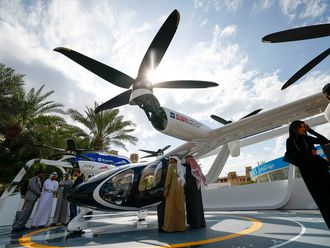The key buzz-point for this week's airshow was no doubt the opening day order by Emirates of 50 Boeing 777-300ERs with options on a further 20 of the type — a potential $26 billion (Dh95.4 billion) deal for Boeing based on current list prices.
Questions about whether Emirates could induct and sustain such a large order, given the fact that it still has some 41 more 777-300ERs yet to be delivered overlook several key drivers behind this big order. For a start, Emirates has a sizeable number of airplanes that they will start to withdraw — therefore not all of the 90-plus 777-300ERs it has on order are strictly for growth. A quick glance of the breakdown of airplane replacements is below:
- 10x Airbus A340-500
- 8x Airbus A340-300
- 27x Airbus A330-200
- 3x Boeing 777-200
- 6x Boeing 777-200ER
- 12x Boeing 777-300
With almost 70 airplanes to be phased out before the end of the decade, the new numbers of airplanes added for intended growth now appear to be conservative and not as outlandish as first envisaged.
Furthermore, what makes Emirates unique is that its sixth freedom right strength in pulling in customers from a litany of overseas routes through its ever-congested Dubai hub and then on to final destinations is supported by the critical mass of over 2.5 billion people that live within just 5.5 hours flying time from Dubai. That sort of market cannot be ignored — particularly when places such as southern Europe and northern Africa still have a long way to go to develop meaningful airport infrastructure to allow their own domestic airlines to grow. In the meantime, Emirates, Etihad and Qatar Airways are all identifying those parts of the global network that have limited services or where competition is thin.
With many hundreds of Airbus and Boeing jets on order in the GCC, it's wise to note that this region is unique in that there are very few old high-capacity airplanes that need to be replaced. Of course there are concerns that filtering too much traffic into places like Dubai, Doha and Abu Dhabi runs the risk of passenger bottlenecks and delays, but airplane orders have been augmented with investment in airport development.
Fuel efficiency
The real challenge is not so much the quantity of airplanes on order but their deliveries. With Airbus still not being able to stabilise A380 production and now the knock-on effects of the A350XWB delays (on all three variants) as well as the production setbacks suffered by the 787 in the wake of its own three-year delays means that these airlines have to wait longer for newer, fuel-efficient jets. With fuel bills escalating, opting for big efficient twins like the 777-300ER has become a necessity, not a knee-jerk reaction.
Linked to this is the need to train and retain pilots, engineers and crew. This is one dynamic that no one really has an answer for because all the major full service and low-cost airlines in the GCC need extra staff and right now there is an industry-wide shortage. With that in mind, it's easy to look at big airplane numbers and worry whether these sorts of announcements are real or whether we should dismiss them.
What's important is that the Middle East has become a global nexus for travel that is expanding faster than anywhere else in the world. To ignore the underlying strengths of the GCC would be at one's peril. That's why Europe's airlines are particularly fearful of these big Arab carriers as they have adapted to competitive change much faster and that's an attribute that ensures customers keep flying with them to and through the GCC.
Saj Ahmad is founder and chief aerospace, defence and airline analyst of FBE Aerospace and Fleetbuzz Editorial










